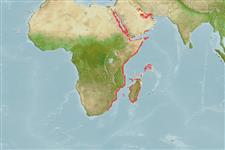Classificação / Names
Common names from other countries
Referência principal
Tamanho / Peso / Idade
Max length : 27.0 cm TL macho/indeterminado; (Ref. 50671); common length : 20.0 cm TL macho/indeterminado; (Ref. 30573)
Length at first maturity
Lm 13.7 range ? - ? cm
Ambiente
; marinhas; estuarina associadas(os) a recifes; intervalo de profundidade 1 - 30 m (Ref. 50672)
Clima / Intervalo
Subtropical, preferred ?; 32°N - 36°S, 25°E - 58°E
Distribuição
Descrição suscinta
Espinhos dorsais (total): 13; Raios dorsais (total): 10; Espinhos anais 7; Raios anais : 9; Vértebras: 23. Upper body gray, green or brownish, silvery below; iris iridescent silver or golden. Body color patterns extend to the fins. Spines slender, pungent and venomous. Preopercular angle 88°-96°; cheeks scaled; midline of thorax, isthmus and midline of belly without scales. Frightened fish become mottled or with 6 diagonal zones across side. Tip of broad-based flap of anterior nostril reaching at least halfway to orifice of posterior nostril.
Status na Lista Vermelha da IUCN (Ref. 115185)
Uso pelos humanos
Pescarias: pouco comercial; Aquacultura: espécies comerciais
Mais informação
ReferênciasAquaculturaPerfil para aquaculturaEstirpesGenéticaFrequência alélicaHereditariedadeDoençasProcessamentoMass conversion
Ferramentas
Relatórios especiais
Baixar XML
Fontes da internet
Estimates of some properties based on models
Phylogenetic diversity index
PD50 = 0.5000 many relatives (e.g. carps) 0.5 - 2.0 few relatives (e.g. lungfishes)
Nível Trófico
2.0 ±0.0 se; Based on diet studies.
Resiliência
Médio, tempo mínimo de duplicação da população 1,4 - 4,4 anos (K=0.22, tm=1-2)
Vulnerabilidade
Low to moderate vulnerability (32 of 100)
Categoria de preço
